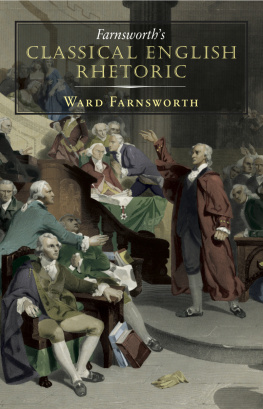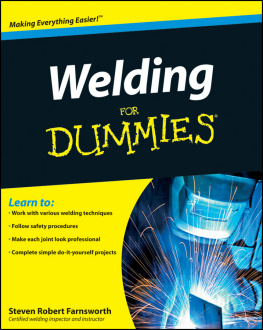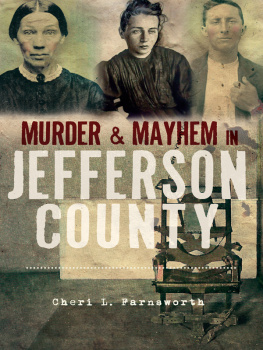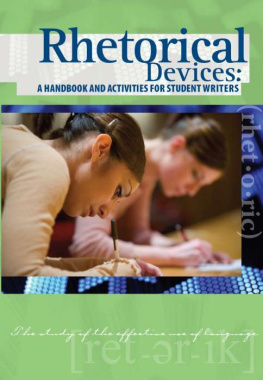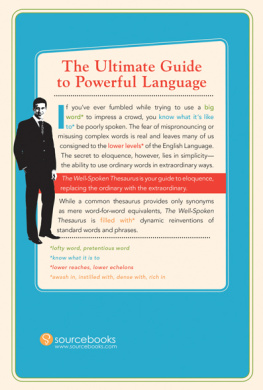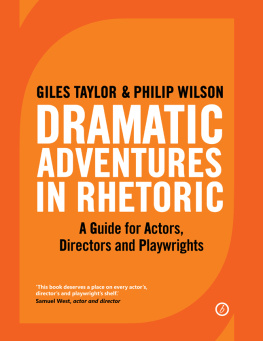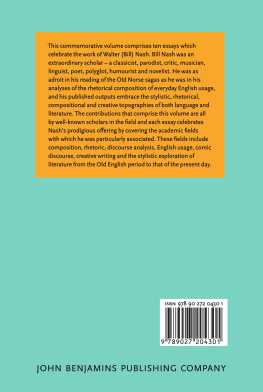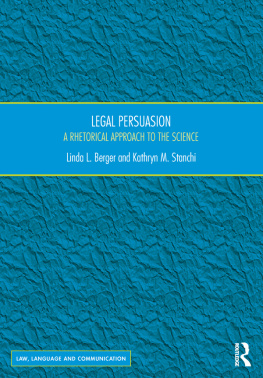PREFACE
EVERYONE SPEAKS and writes in patterns. Usually the patterns arise from unconscious custom; they are models we internalize from the speech around us without thinking much about it. But it also is possible to study the patterns deliberately and to learn more about how to use the ones that make the words they arrange more emphatic or memorable or otherwise effective. The most famous such patterns, known as rhetorical figures , were first identified and studied in ancient Greece and Rome. Most of them amount to departures from simple and literal statement, such as repeating words, putting words into an unexpected order, leaving out words that might have been expected, asking questions and then answering them, and so forth. Figures of these kinds amount to practical ways of working with large aesthetic principles repetition and variety, suspense and relief, concealment and surprise, the creation of expectations and then the satisfaction or frustration of them all as they apply to the composition of a simple sentence or paragraph. This book is meant as a help to those who wish to be on better terms with such techniques. It aims to show in detail what can be done with major rhetorical figures and the best of what has been done with them in English, to present the occasions for their use in systematic fashion, and to offer explanatory comments in moderation.
Rhetoric is a vast, old, and honorable discipline. It may be defined most broadly and simply as the use of language to persuade or otherwise affect an audience. The decline of rhetoric in our times is thus a much broader phenomenon than any mere decline in familiarity with figures of speech, but figures nevertheless are a good place to begin a study of the subject because they tend to be easy to explain, instructive to examine, and frequently useful. It certainly is possible to write well without rhetorical figures, but most of the best writers and speakers the ones whose work has stood up the longest have made important use of them, and figures tend to show up often in utterances that are long remembered. The point is not that figures are useful for writing things that one hopes will last, for writing anything in that hope is almost always a mistake. The point, rather, is that durability is one measure of the excellence of a style and the value of the techniques that it employs. It helps us think about quality in ways more interesting than asking what panders best to the fashions of the moment.
Rhetorical figures also show up often, of course, in a lot of bad speech and writing. When used in contemporary political speeches and read from teleprompters, figures often sound tinny like clichs, or strained efforts to make dull claims sound snappy. This is partly because todays politician tends to be a creature of very modest literacy and wit who spoils what he touches, but there are more specific reasons as well. First, figures sound splendid when used to say things worth saying. They can show a worthy sentiment to great advantage. But they merely are grating when used to inflate the sound of words that are trite or trivial in substance, a regrettably common use of figures that has helped give a bad name to rhetoric in general. Secondly, an otherwise promising use of a figure often goes wrong because the speaker overdoes it. Too much ornament in any art tends to leave a worse impression than too little. Skilled and experienced students of rhetoric sometimes are able to use a high density of figures to strong effect (we will see examples soon enough), but for most people most of the time an attractive use of these patterns requires moderation and restraint. Thirdly, rhetorical figures only become powerful when they sound spontaneous and are integrated smoothly into the rest of the way a speaker talks. Most of them come to notice in the first place because people use them unwittingly when they speak from passion and with a dash of inspiration. (My young children, when wrathful, are masters of hypophora.) Thus a mediocre speech or piece of writing often announces itself by the forced use of a rhetorical figure too freshly learned or deliberately employed.
But then how does one study techniques that succeed only when they seem unstudied? The answer lies in examples. Rhetorical figures start to sound natural once one has spent so much time with them that they come to mind without effort, and finally serve as shapes into which words assemble themselves by instinct when the situation calls for it. Examples also can do more than exposition to teach lessons about the beauty of a device, about its technical details, and about the occasions for its use for a sense of the occasion is as important as anything in the mastery of rhetorical figures. Some of them are suited to the expression of certain sorts of ideas or feelings, but sound strange otherwise; some fit well into certain kinds of writing and speech, but have little or no place in others; some things that can be done with figures are rarely useful at all, yet are indispensable once or twice in a lifetime. (One wants to be ready.) Examples, if they are to teach all these things, must be not only apt but extensive. Seeing just a few examples invites direct imitation of them, which tends to be clumsy. Immersion in many examples allows them to do their work by way of a subtler process of influence, with a gentler and happier effect on the resulting style.
As a practical matter this approach to the study of figures means spending a great deal of time in the company of writers who know the devices intimately and have good taste. This book performs the necessary introductions. It contains more than a thousand illustrations drawn from British, Irish, and American oratory and literature. The right first question about any pattern for the arrangement of words, and the question asked in each chapter of this book, is what use masters of the language have made of it: how Lincoln put it to work, or Churchill, or Burke, or the American founding fathers; or Dickens and Melville, or Shaw and Chesterton, or the Irish orators Henry Grattan and Richard Lalor Sheil but the reader will see. The masters of the rhetorical figure in English include many storied writers and talkers, but also others less well known. Making your own first acquaintance with them is part of the fun of studying their craft.
Most of the examples here are from English prose rather than verse. They start around 1600, the age of Shakespeare and the King James Bible, and end around 1950. The largest share are from the nineteenth century and the latter part of the eighteenth. This selection reflects one of the chief purposes of the book, which is to help recover a rhetorical tradition in English that is less familiar because it is outside of living memory and is fast becoming more distant as a cultural and stylistic matter. (Thus the word classical in the title.) The better authors and statesmen of those earlier periods studied rhetoric more closely than it tends to be studied today, and the English of their times was more hospitable to its charms. We may not want to talk now quite as people did in earlier times; in some respects we are indeed forbidden to talk that way by our culture. But the ablest of the older writers still make the best teachers of rhetoric.
Last, a few notes on what this book does not do. It does not come close to discussing every known rhetorical figure. It just covers the eighteen or so that, in my judgment, are of most practical value. Metaphor and simile are omitted here, too, not because they are unimportant but because they are too important; they are large enough topics to require separate treatment of their own. The book also avoids anything translated into English from other languages, with the exception of the King James Bible and passing mention of some famous French examples. The details that give a rhetorical figure its entire sound tend not to come through in translation, and in any event the use of rhetorical figures in English is extensive enough to support treatment by itself and important enough to need it. For this reason, too, the book pays relatively slight attention to classical origins of the devices it considers. In each case I do give the name for the device derived from Ancient Greek (or, occasionally, from Latin); those labels, however strange they may sound at first, end up being highly convenient if you spend much time with this subject. But the chapter titles also identify the devices with English words that are more likely to be clear, and in some chapters I also offer, near the start, a familiar example or two of the use of the figure in relatively recent times. More generally the book spends little time on details of taxonomy. There are hundreds of names for all the rhetorical figures that have ever been identified, and arguments about which names apply to which figures, and then more distinctions to draw between figures of speech and figures of thought, between schemes and tropes, and on and on. I do not disparage those distinctions, but this book is not about them. The reader unhappy with the books insouciance on these points, or who just would like to pursue taxonomy in more detail, has plenty of recourse, some examples of which will be mentioned in the bibliographical notes.

